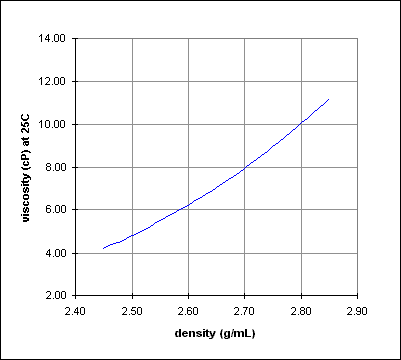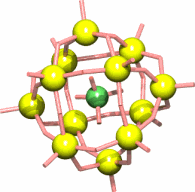LST Fastfloat heavy liquid information
LST Fastfloat: heavy liquid for density separations
Description and applications
LST Fastfloat consists of low toxicity sodium heteropolytungstates dissolved in water. It is a high density liquid for laboratory based density separations, supplied at a density of 2.80 g/mL but capable of being used up to a density of 2.95 g/mL at 25 °C.
LST Fastfloat is the lowest viscosity water based heavy liquid available. Its viscosity of 10 cP at a density of 2.80 g/mL is similar to that of tetrabromoethane (TBE), and only half that of sodium polytungstate (SPT) or lithium polytungstate (LMT). Equivalent float-sink separations with LST Fastfloat are twice as fast as with sodium or lithium polytungstate. Due to its low viscosity, LST Fastfloat dissolves more rapidly, washes more easily from minerals, and filters more quickly.
LST Fastfloat is also one of the most heat stable water based heavy liquids. Dilute washings can be heated to boiling during recovery, and even if it dries out there is no decomposition of the sodium heteropolytungstate - even up to 180 °C. Because of this high thermal stability, recycling of “washings” from minerals is fast and efficient.
Like sodium polytungstate, LST Fastfloat is used wherever a safe heavy liquid is needed for density separations of minerals, conodonts, pollen grains, mineral sands, zircon, diamond indicator minerals, and other materials in industry and research. LST Fastfloat is suitable for use in geology, geochemistry, geochronology, materials separations, metallurgy and palynology.
Physical Properties
Density of heavy liquid as supplied: 2.80 ±0.2 g/mL
Viscosity of heavy liquid as supplied: 10 ±1 cP
Crystallising point as supplied: 16 - 18 °C
Density of saturated solution at 25 °C: 2.95 g/mL*
Density of saturated solution at 50 °C: 3.20 g/mL**
Solids content of saturated solution at 25 °C: 80 ±1 %
* after evaporating 7 mL water / 100 mL supplied heavy liquid
** after evaporating 17 mL water / 100 mL supplied heavy liquid
pH: 4 ±1
Boiling point of heavy liquid: 105 ±1 °C
Flammability: not flammable
Flash point: none
n-octanol - water partition: Pow < 0.001
A graph of viscosity vs density is given in Figure 1, below.

Figure 1: LST Fastfloat viscosity (cP) vs density (g/mL)
Safety
LST Fastfloat contains the sodium salt of low toxicity heteropolyanions in an aqueous solution. LST Fastfloat contains no organic solvents and does not produce any fumes, so fume cupboards are not required.
As with any work in the laboratory, rubber gloves and laboratory safety glasses should be worn when using LST Fastfloat.
If LST Fastfloat accidentally comes in contact with the skin, wash the contaminated area with clean water. LST Fastfloat is very water soluble, and is rapidly removed by rinsing an affected area with water.
If LST Fastfloat accidentally comes in contact with the eyes, immediately flush the affected eye with plenty of clean water for 2 minutes, then seek medical attention as appropriate.
Only use LST Fastfloat under conditions of acceptable laboratory safety practice.
Laboratory Usage
When using LST Fastfloat heavy liquid the following notes should be considered.
After a float-sink separation, grains can be washed clean of heavy liquid with deionised water, and the washings can be reconcentrated in an oven or on a thermostatted hotplate stirrer to recycle the LST Fastfloat.
It is faster to evaporate water from LST Fastfloat washings on a hotplate if the solution is stirred while heating, and if an air stream is passed over the heated liquid’s surface.
Dried heavy liquid solids resulting from excessive evaporation can be dissolved by warming to 50-60 °C in a little deionised water while stirring with a magnetic stirrer.
It is good practice to re-check the density before using LST Fastfloat, since evaporation of water from the heavy liquid will increase the density.
Use only equipment made of plastic, glass or high quality (e.g. “316”) stainless steel when working with LST Fastfloat. Avoid contact of LST Fastfloat with most other metals such as iron, copper, etc. LST Fastfloat will slowly react with metals to form a dark blue solution. The colour is from chemical reduction (gain of electrons) and can normally be reversed by adding a few drops of 30% hydrogen peroxide solution and heating for 30 minutes.
Contamination with soluble salts will degrade the heavy liquid performance of LST Fastfloat, preventing the highest densities from being obtained. Do not mix sodium polytungstate solutions with LST Fastfloat because the two materials are not compatible: a mixture of the two will not reach high densities.
LST Fastfloat is not compatible with alkaline chemicals or alkaline solids such as lime.
Only deionised water should be used for diluting LST Fastfloat heavy liquid. Similarly, only deionised water should be used when washing minerals after heavy liquid separations.
Wherever possible keep laboratory temperatures above 20 °C, since chilling below 20 °C can cause crystallisation in heavy liquids with density above 2.8 g/mL. Any crystals which form can be redissolved in the heavy liquid by warming to 50-60 °C and magnetically stirring the liquid for a short time.
More questions?
Answers to some common questions can be found in our Frequently Asked Questions section.
LST Fastfloat Brochure
If you wish, you can download an Adobe Acrobat (.pdf) format brochure containing technical and other information on LST Fastfloat.
Thank you for your interest. We look forward to being able to help you with your heavy liquid requirements in the near future.

